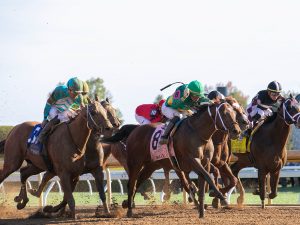By Ray Wallin

Horse Racing – USR Photo
In life there is information that you should use and information that you should avoid using. When your doctor tells you that you should work out more and cut your salt intake for your health, you listen and use that information. When some creepy cousin of Rail Guy tells you that he has some dirt cheap Prada bags in his trunk that he wants you to have, you avoid this kind of information.
The same is true with pace handicapping. Winning horseplayers and those that make their living playing the races know the difference between what running lines to use for pace analysis and what running lines to avoid for pace analysis, even if it means digging a little deeper into the past performances to find the right one.
What should you look to avoid?
#1 Atypically fast fractions
You are looking at the running lines of Gluestick Gus in the fifth race when you see that in his last 6-furlong race he hit the half mile in 44.80 seconds a few lengths from the lead and plodded his way to a respectable fourth-place finish against a similar field. If he is able to handle a pace like this he will be in the mix in today’s race, right?
Maybe not.
Looking down the past performances at other applicable sprint races you don’t see any other races where he was remotely competitive that have a half-mile call in anything under 46.60 seconds, even after you make track-to-track adjustments.
You need to toss this race and find another race to use in your analysis. Either the track was running fast in that last race (check the track variant) or good old Gus had some “special” feed that morning. It is unlikely that he will run to this blazing fraction again today, especially if he is an older horse.
#2 Atypically slow fractions
Besides avoiding using races with atypically fast fractions, you need to do the same when you encounter races with atypically slow fractions.
Using Gluestick Gus as an example again, you see another running line where he ran a competitive 6-furlong race where the half-mile call was in 48.40 seconds. Every other race is in the range of 46.60 to 47.20 seconds.
Like you don’t want to give him extra credit for the blazing fractions in the first example, you shouldn’t penalize him for the track running slow one day either.
#3 Troubled trips
Most novice handicappers I know fail to read the running line all the way across to the right. Most stop at the column listing the odds of the horse in each running line instead of making it to the “Comments” on that race.
Why is this important?
While not providing the full story of the events of that race, the comments column at least alerts you to a reason why the horse may not have run their best race. In the case of a horse that has a solid showing with trouble with no other applicable running lines; you can give him some extra credit in your analysis for overcoming being steadied early or bumped hard at the start and still managing to finish with a couple lengths of the winner. You can expect to see improvement from that effort in subsequent starts.
#4 One-turn to two-turn (and vice versa)
Some horses are better sprinters while others prefer routes. When looking at route distances, avoid using one-turn routes, such as the mile from tracks like Belmont Park, when comparing to two-turn miles. This also applies the other way when looking to compare two turn sprints, like 6 1/2 furlongs from Charles Town to one-turn sprints at other tracks.
Why does this matter?
Have you ever noticed that many one-turn route horses from Aqueduct and Belmont ship to Saratoga and run poorly?
One-turn routes run faster fractions than two-turn races of the same distance and only need to negotiate one turn. Two-turn routes also start closer to the first turn than the one-turn routes which does lend those races to favoring the inside posts. There are always more chances for trouble when maneuvering a second turn. Often the two-turn route tracks have a shorter stretch than the one-turn tracks, which leaves less time for horses to recover and make their run leaving the final turn.
This situation is often unavoidable depending on where horse has spent a bulk of their career racing, so use these running lines with caution if you need to and know how all the tracks you play or see shippers from are configured.
#5 Outclassed
Patty the Plodder has settled into a career of conditioned $5,000 claiming races in her later years. A couple races back she changed hands to a new trainer that ran her in a $16,000 open claimer where she had a dismal performance. She then went into a series of starter allowance races for $8,000 horses where she struggled.
She was outclassed in the $16,000 race and the starter allowances. By this point in her career, she has proven to be a $5,000 horse and the representative pace line should show that. She’ll likely take a shot at a $6,250 race or drop to a $4,000 race, but anything else isn’t a level where she belongs.
#6 Underclassed
The flip side to Patty the Plodder is if you have a solid $16,000 claiming horse that drops suddenly down to a $4,000 claiming race and dominates. Chances are they won for fun and didn’t need to try as hard at that level of competition.
Horses often run to the level of their competition. If a higher classed horse faces a very weak field, they will run slower. If you have track-to-track par data that is sorted by class at each track, you can see how each class level differs by a couple of fifths of a second as you climb the class ladder.
By using a running line against inferior competition, you are selling this contender short.
#7 Wrong surface
Some horses love the dirt, others love the grass, and still others run their best on all-weather tracks. While I will use dirt to all-weather and vice versa if the horse has shown they can run on both surfaces, I never use a turf race running line to dirt or all-weather.
Turf racing fractions are less consistent than dirt or all-weather surfaces since tracks move the rail in and out to protect the surface in locations. This changes the configuration of the track which will make it hard to compare any turf race to a non-turf race or even another turf race.
When you see a turf race with a sizable swing in fractional times, it is best to handicap the pace on running styles and not by using fractions.
#8 Off tracks
Sloppy tracks can run faster than a fast track and muddy tracks are often slower. There is no universal adjustment for an off track surface.
Some horses run their best in the slop or mud, others run horribly. Whether it is pedigree or the horse’s personal preference, either way avoid off track running lines unless you are handicapping for an expected off track condition.
#9 Race of a lifetime
Nellie the Nag ran the race of a lifetime in her last race. She bested her previous lifetime best speed figure by 20 points. Will she be able to do it again?
Chances are she won’t. Older horses are consistent and start to lose a step around five years old. Some people call it bounce, I prefer “regression to the mean.” Horses run better or worse than their average, but will have good and bad races that cause them to have a consistent average.
The exception to using a lifetime best is with 2-year-olds and younger 3-year-olds. These animals are still maturing and developing. It is not uncommon to see them show signs of improvement of several consecutive races. It is the older animals that should have peaked that are not likely to repeat that magical performance again.
By avoiding the wrong running lines you will have a representative picture of the pace for your analysis. It takes a deeper dive into the past performances and knowing the configurations of the different tracks that are in those running lines. Remember to adjust track-to-track and avoid these common pitfalls so your bankroll can continue to grow.

Ray Wallin is a licensed civil engineer and part-time handicapper who has had a presence on the Web since 2000 for various sports and horse racing websites and through his personal blog. Introduced to the sport over the course of a misspent teenage summer at Monmouth Park by his Uncle Dutch, a professional gambler, he quickly fell in love with racing and has been handicapping for over 25 years.
Ray’s background in engineering, along with his meticulous nature and fascination with numbers, parlay into his ability to analyze data; keep records; notice emerging trends; and find new handicapping angles and figures. While specializing in thoroughbred racing, Ray also handicaps harness racing, Quarter Horse racing, baseball, football, hockey, and has been rumored to have calculated the speed and pace ratings on two squirrels running through his backyard.
Ray likes focusing on pace and angle plays while finding the middle ground between the art and science of handicapping. When he is not crunching numbers, Ray enjoys spending time with his family, cheering on his alma mater (Rutgers University), fishing, and playing golf.
Ray’s blog, which focuses on his quest to make it to the NHC Finals while trying to improve his handicapping abilities can be found at www.jerseycapper.blogspot.com Ray can also be found on Twitter (@rayw76) and can be reached via email at ray.wallin@live.com.


